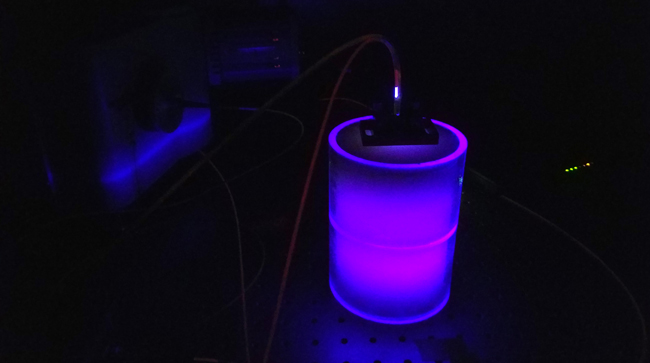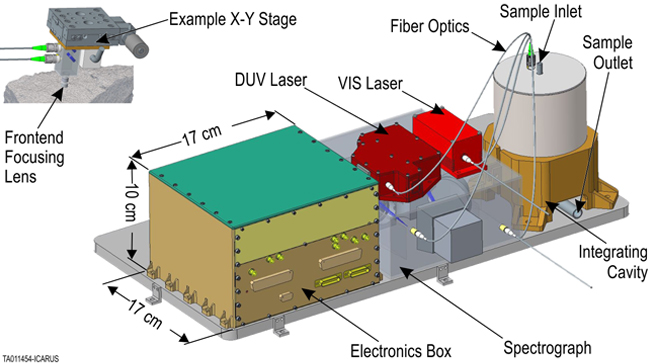BACKGROUND
Jupiter’s moon Europa has an icy shell covering a large global liquid water ocean with likely hydrothermal vents at the ocean floor – this environment may be conducive to the formation of life. The search for biological signatures on Europa requires a lander mission payload with exquisite capabilities for spectroscopic analysis of ice sample composition to characterize the biological potential. The Deep Ultraviolet (Deep-UV) Raman spectroscopy technique is well suited for key measurements of biologically relevant species, including organics, isotopes, amino acids, and other complex molecules. However, a Raman spectrograph instrument customized for planetary science investigations has not yet flown in space, making this area of study well suited for rapid growth and innovations.
APPROACH
SwRI is developing a high-sensitivity Deep-UV + Visible dual-laser Raman system for spaceflight to address astrobiological science goals applicable to ocean worlds such as Europa. Our Raman Spectrograph for Ocean worlds (RSO) instrument design utilizes a technique called integrating Cavity Enhanced Raman Spectroscopy (iCERS), which was developed by collaborators at Texas A&M University and advanced in a previous internal research program unrelated to space science. This iCERS approach has already demonstrated a few orders of magnitude enhancement of Raman signal and femtomolar level measurement sensitivity, making it well suited to searches for trace biosignatures in icy samples.
Baseline iCERS Deep UV measurements for astrobiology sample types
Beamline tests at MIT to characterize i) fluorescence from MeV electrons and gammas and ii) color center production rate/reflectance degradation vs. dose rate
Analytical modeling of radiation effects, fluorescence yield, etc., for both partially sintered and compressed powder options for the cavity material and design
Detector radiation characterization within landed spacecraft vault
Full measurement background subtraction characterization
Additional solid model, thermal design, and mechanisms tasks
Vibration testing a prototype cavity
ACCOMPLISHMENTS
Several prototype integrating cavities were used to measure ice sample mixtures with amino acids (glycine), deuterated water ice, table salt (NaCl), epsom salt (MgSO4), and methanol ice to demonstrate the capability of the initial bench top device to deliver science measurements (even after irradiation). Radiation tests of custom integrating cavities built at SwRI, fiber optic cables, and candidate laser diodes were conducted in a MeV electron beamline at MIT, with radiation levels representative of the Europa environment. No significant performance degradation was detected, and no background signal noise is expected to result from this source as a result of the intense radiation environment when measuring samples on Europa’s surface. Detailed designs for optical, mechanical, electrical, and laser subsystems were developed as planned prior to submitting proposals in response to NASA’s Instrument Concepts for Europa Exploration 2 and Development and Advancement of Lunar Instrumentation opportunities (Figure 2). Our expectation is that the development of SwRI’s enhanced Raman spectrograph system enables new investigations where exquisite compositional measurements of trace minerals are required, which includes not only the most astrobiologically interesting ocean world environments in the solar system, such as Europa, but the Moon and other planetary bodies as well.

Figure 1: Functional prototype of an iCERS cavity operating at SwRI.

Figure 2: Concept for our integrating cavity enhanced Raman spectrograph. Subsequent proposals to NASA will move our concept to a TRL 5 brassboard implementation, with TRL 6 quickly achievable in a spaceflight mission program.
